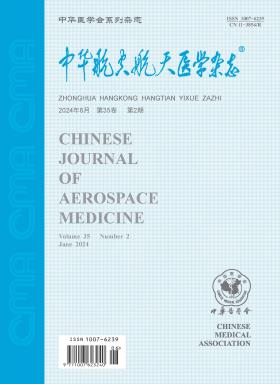Comparative analysis on data of ear baric function by hypobaric chamber test between helicopter and fighter pilots
引用次数: 0
Abstract
Objective To compare the ear baric function of helicopter pilots and fighter pilots and to investigate the aeromedical support on helicopter pilots' ear baric function. Methods One hundred and thirty helicopter pilots and 90 fighter pilots were inquired about their health history and examined by electric otoscopy (EOS), pure tone audiometry (PTA), acoustic immitance measurement (AIM), rhinoscopy (RS) and nasal endoscopy (NES). Those who were without contraindication to hypobaric chamber test (HCT) were subjected to HCT as follows: ①both helicopter and fighter pilots were asked to sit in the chamber and climbed up to 4000 m with the velocity of 15-20 m/s, remained for 5 min and then declined to ground level with the velocity of 5 m/s; ②fighter pilots were climbed to 4 000 m with the velocity of 20-30 m/s, stayed for 5 min and declined to the ground level with the velocity of 20-25 m/s. After HCT, they were re-examined by EOS, PTA and AIM. The incidence of ear baric dysfunction (EBDF) was compared between helicopter and fighter pilots. Results ①One helicopter pilot did not undergo HCT due to cold-induced grade II eardrum congestion diagnosed by EOS, mild conductive hearing loss by PTA and C-shaped curve by AIM. ②The incidence of EBDF was 6.20% in helicopter pilots when they were declining with slow rate (5 m/s), significantly higher than that in fighter pilots (0.00%) (χ2=4.16, P 0.05). Conclusions It should take different climbing and descending rates in the HCT ear baric function evaluation or aeromedical training for different aircraft pilots. Key words: Ear, middle; Barotrauma; Hypobaric chamber; Pilots直升机与战斗机飞行员低压舱试验耳压功能数据对比分析
目的比较直升机飞行员与战斗机飞行员的耳压功能,探讨直升机飞行员耳压功能的航空医疗保障措施。方法对130名直升机飞行员和90名战斗机飞行员进行健康史调查,采用电耳镜(EOS)、纯音听力学(PTA)、声阻抗测量(AIM)、鼻内镜(RS)和鼻内窥镜(NES)检查。对无低压舱试验禁禁症的飞行员进行如下试验:①直升机和战斗机飞行员均坐在低压舱中,以15 ~ 20 m/s的速度爬升至4000 m,停留5 min,然后以5 m/s的速度下降至地面;②战斗机飞行员以20 ~ 30 m/s的速度爬升到4000 m,停留5 min后以20 ~ 25 m/s的速度下降到地面。HCT后复查EOS、PTA、AIM。比较了直升机和战斗机飞行员耳压功能障碍(EBDF)的发生率。结果①1名直升机飞行员因EOS诊断为冷致II级耳膜充血,PTA诊断为轻度传导性听力损失,AIM诊断为c型曲线,未行HCT。②直升机飞行员慢速下降(5 m/s)时EBDF发生率为6.20%,显著高于战斗机飞行员(0.00%)(χ2=4.16, p0.05)。结论不同机型飞行员在HCT耳压功能评估或航空医学训练中应采取不同的爬升率和下降率。关键词:耳,中部;气压性创伤;低比重的室;飞行员
本文章由计算机程序翻译,如有差异,请以英文原文为准。
求助全文
约1分钟内获得全文
求助全文
来源期刊

中华航空航天医学杂志
航空航天医学
自引率
0.00%
发文量
2962
期刊介绍:
The aim of Chinese Journal of Aerospace Medicine is to combine theory and practice, improve and popularize, actively advocate a hundred flowers bloom and a hundred schools of thought contend, advocate seeking truth from facts, promote the development of the related disciplines of aerospace medicine and human efficiency, and promote the exchange and penetration of aerospace medicine and human efficiency with other biomedical and engineering specialties.
Topics of interest for Chinese Journal of Aerospace Medicine include:
-The content of the journal belongs to the discipline of special medicine and military medicine, with the characteristics of multidisciplinary synthesis and cross-penetration, and mainly reflected in the aerospace industry, aerospace flight safety and efficiency, as well as the synthesis of special medicine, preventive medicine, environmental medicine, psychology, etc.
-Military aeromedicine (Air Force, Navy and Army aeromedicine) and civil aeromedicine, with a balance of aerospace medicine are the strengths of the journal.
-The change in aerospace medicine from a focus on promoting physiological compensatory adaptations to enhancing human performance under extreme environmental conditions is what the journal is helping to promote.
-The expansion of manuscripts in high altitude medicine is also a special emphasis of the journal.
 求助内容:
求助内容: 应助结果提醒方式:
应助结果提醒方式:


